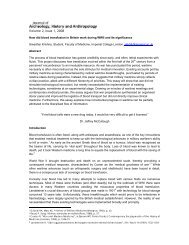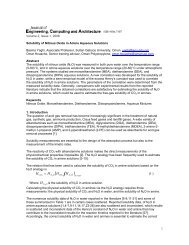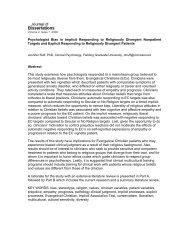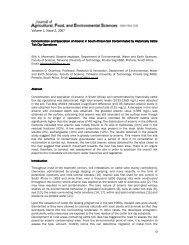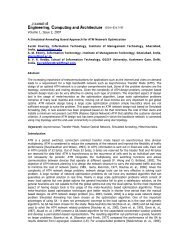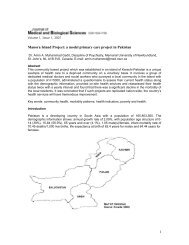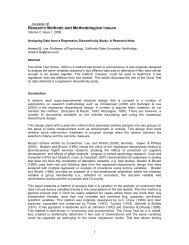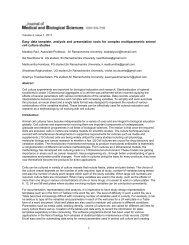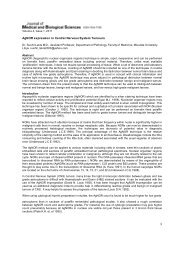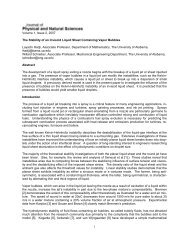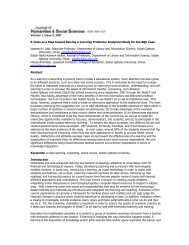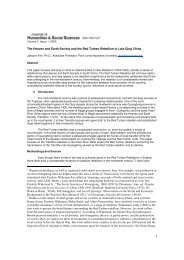Survey of Network on Chip (NoC) Architectures & Contributions ...
Survey of Network on Chip (NoC) Architectures & Contributions ...
Survey of Network on Chip (NoC) Architectures & Contributions ...
You also want an ePaper? Increase the reach of your titles
YUMPU automatically turns print PDFs into web optimized ePapers that Google loves.
employed for transmissi<strong>on</strong> <str<strong>on</strong>g>of</str<strong>on</strong>g> flits. The cost functi<strong>on</strong>s for the QNOC implementati<strong>on</strong> were calculated based <strong>on</strong> the<br />
estimati<strong>on</strong> <str<strong>on</strong>g>of</str<strong>on</strong>g> area occupied by its comp<strong>on</strong>ents. Were also provided other performance parameters such as clock<br />
rate, end-to-end delay (latency <str<strong>on</strong>g>of</str<strong>on</strong>g> packet), and power c<strong>on</strong>sumpti<strong>on</strong> under different traffic loads.<br />
Ethereal NOC<br />
The Ethereal NOC developed by Phillips aims at achieving composability and predictability in system design and<br />
eliminating uncertainties in interc<strong>on</strong>nects, by providing guaranteed throughput and latency services [10], [21]. It<br />
provides run-time rec<strong>on</strong>figurati<strong>on</strong>. The Phillips NOC has an instance <str<strong>on</strong>g>of</str<strong>on</strong>g> a 6-port router with an area <str<strong>on</strong>g>of</str<strong>on</strong>g> 0:175 mm 2<br />
after layout, and a network interface with four IP ports having a synthesized area <str<strong>on</strong>g>of</str<strong>on</strong>g> 0:172 mm 2 . All the queues are<br />
32-bits wide and 8-words deep. Hardware FIFOs (First In First Out) are used for implementing queues. Both the<br />
router and the network interface are implemented in 0:13 µm technology, and run at 500 MHz. The NI is able to<br />
deliver the BW <str<strong>on</strong>g>of</str<strong>on</strong>g> 16 Gbits/sec to all the routers in the respective directi<strong>on</strong>s. It is a topology-independent NOC. The<br />
NOC mainly c<strong>on</strong>sists <str<strong>on</strong>g>of</str<strong>on</strong>g> two comp<strong>on</strong>ents: the NI and the router, with multiple links between them. The NI <str<strong>on</strong>g>of</str<strong>on</strong>g>fers the<br />
standard interface, such as AXI or OCP to the IP modules c<strong>on</strong>nected to the NOC. The NOC provides BE and GT<br />
service levels. A time-divisi<strong>on</strong> multiplexed circuit switching approach with c<strong>on</strong>tenti<strong>on</strong>-free routing has been<br />
employed for GT. It uses wormhole routing with input queuing to route the flits. The router exploits source routing.<br />
GT flits are always scheduled for being routed in the next clock cycle, whereas BE flits are scheduled as per a<br />
round-robin criteri<strong>on</strong>. Credit-based end-to-end flow c<strong>on</strong>trol has been implemented to make sure that no flit is<br />
transmitted unless there is enough space in the destinati<strong>on</strong> buffer to accommodate it. The Phillips NOC implements<br />
the NI in two parts: the NI kernel and the NI shell. The NI kernel communicates with the NI shell via ports.<br />
SPIN NOC<br />
The Scalable Programmable Integrated <str<strong>on</strong>g>Network</str<strong>on</strong>g>-<strong>on</strong>-chip (SPIN) is based <strong>on</strong> a fat-tree topology [8], [41]. It<br />
addresses design decisi<strong>on</strong>s such as the nature <str<strong>on</strong>g>of</str<strong>on</strong>g> links, the packet structure and the network protocol. It is based<br />
<strong>on</strong> two kinds <str<strong>on</strong>g>of</str<strong>on</strong>g> comp<strong>on</strong>ents: initiators and targets. The system can have different numbers <str<strong>on</strong>g>of</str<strong>on</strong>g> cores for each type.<br />
The initiator comp<strong>on</strong>ents are traffic generators, which send requests to the target comp<strong>on</strong>ents. The target<br />
comp<strong>on</strong>ent sends a resp<strong>on</strong>se as so<strong>on</strong> as it receives a request. All the comp<strong>on</strong>ents in the system are designed to<br />
be VCI (Virtual Socket Interface) compliant. SPIN is a packet-switching <strong>on</strong>-chip micro-network, which uses<br />
wormhole switching, adaptive routing and credit-based flow c<strong>on</strong>trol. It is based <strong>on</strong> a fat-tree topology, which is a<br />
tree structure with routers <strong>on</strong> the nodes and terminals <strong>on</strong> the leaves, except that every node has replicated fathers.<br />
In a full 4-ary fat-tree topology, there are as many fathers as children <strong>on</strong> all nodes (routers). Such a topology<br />
produces a n<strong>on</strong>-blocking network with a performance that scales gracefully with the system size. Links are bidirecti<strong>on</strong>al<br />
and full-duplex, with two unidirecti<strong>on</strong>al channels. The channel's width is 36 bits wide, with 32 data bits<br />
and 4 tag bits used for packet framing, parity and error signaling. Additi<strong>on</strong>ally, there are two flow c<strong>on</strong>trol signals<br />
used to regulate the traffic <strong>on</strong> the channel. In SPIN, packets are defined as sequences <str<strong>on</strong>g>of</str<strong>on</strong>g> 32 bits data words, with<br />
the header fitting in the first word. An 8-bit field in the header is used to identify the destinati<strong>on</strong> terminal, allowing<br />
the network to scale up to 256 terminals. The payload has an unlimited length as defined by two framing bits (Begin<br />
Packet / End <str<strong>on</strong>g>of</str<strong>on</strong>g> Packet). SPIN uses wormhole switching. The input buffers have a depth <str<strong>on</strong>g>of</str<strong>on</strong>g> 4 words, which results<br />
in cheaper routers. Routing in SPIN is adaptive and distributed. The basic building block <str<strong>on</strong>g>of</str<strong>on</strong>g> the SPIN network is the<br />
RSPIN router. It includes eight ports, each port with a pair <str<strong>on</strong>g>of</str<strong>on</strong>g> input and output channels compliant with the SPIN link.<br />
Internally, RSPIN includes a 4 words buffer at each input channel and two 18 words output buffers, shared by the<br />
output channels. They have a greater priority when competing with the input buffer to use an output channel, which<br />
allows reducing the c<strong>on</strong>tenti<strong>on</strong>, whilst minimizing the head-<str<strong>on</strong>g>of</str<strong>on</strong>g>-line blocking by freeing the queues in the input buffers.<br />
RSPIN c<strong>on</strong>tains a partial 10×10 crossbar, which implements <strong>on</strong>ly the c<strong>on</strong>necti<strong>on</strong>s allowed by the routing scheme:<br />
all the packets flowing down the tree can be forwarded to children and <strong>on</strong>ly such packets can use the output buffers<br />
when the required output channel is busy. Nevertheless, <strong>on</strong>ly the packets incoming from children can flow up the<br />
tree and be forwarded to the fathers.<br />
Other NOCs<br />
There have been a sizeable number <str<strong>on</strong>g>of</str<strong>on</strong>g> proposals/implementati<strong>on</strong>s <str<strong>on</strong>g>of</str<strong>on</strong>g> NOCs in the literature. Without being<br />
exhaustive, these include:



